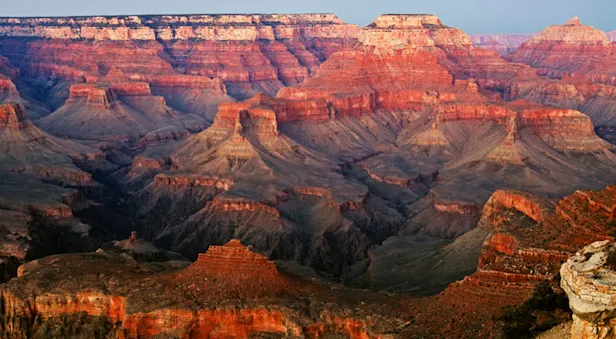
Know Before You Go


Pronghorn Facts | Southwest Canyons Wildlife Guide
The pronghorn is not a true antelope, even though it looks like one and is frequently referred to as the “pronghorn antelope.” It is actually more closely related to the giraffe than true antelopes, which are mainly found in Africa.
Besides appearance, another commonality the pronghorn shares with African antelopes is speed. The pronghorn is the fastest land mammal in North America, having evolved to outrun a now-extinct species of cheetah that once chased it across the Great Plains. They can sprint at 60 miles per hour and easily cruise at 45 miles per hour.
In the early 1800s, it is estimated there were 35 million pronghorns in North America—second only to bison in total numbers. Today they have been reduced to an estimated 500,000 across the western United States.
PHYSICAL DESCRIPTION
The pronghorn is quite small, standing around 3 feet tall at the shoulders and weighing less than 125 pounds. Their coats vary from tan to brown, but the distinctive features are white patches under the stomach and on the rump. They also have two white stripes across the fronts of their necks, and males have black patches on the lower jaw and a black mask extending down the nose.
The pronged horns themselves are unique. Whereas most horns simply grow year after year (as opposed to antlers, which drop each year), the bony core of these horns are covered with a keratin sheath that is shed each year (keratin is the same protein that makes up most of our fingernails and hair). The sheaths do grow back longer every year, and the horns of males average 10 inches long. Females have horns as well, although they are shorter, averaging 4.7 inches in length, and are rarely pronged.
FEEDING HABITS
As pronghorns are widely distributed across several habitat types, their diet depends on local resources. Sage and rabbitbrush make up most of the winter diet of northern pronghorns, while in the summer their focus shifts to fresh grasses. They are able to eat plants that are toxic to other ungulates, possibly because their oversized liver filters out the toxins. Pronghorns do not need to drink water unless the plants they are eating are unusually dry.
BREEDING BEHAVIOR
In the fall, dominant males begin to form territories for the mating season (September–October) and work to gather harems. Younger males are also looking for potential mates during this time, and serious fights can occur. Unlike many other species of ungulates whose fights are basically wrestling matches to determine who is stronger, pronghorn fights involve attempts to injure the opponent. The results are often bloody and sometimes fatal.
After the breeding season, pronghorns spend the winter in mixed-age and mixed-gender herds, following the snow line south.
































